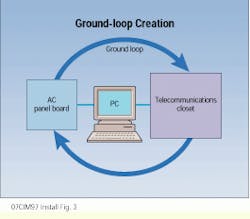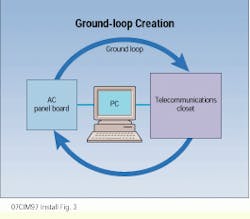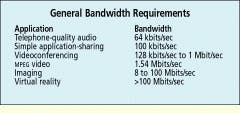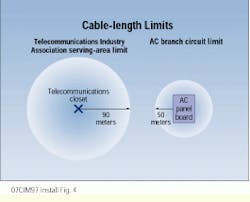Multimedia applications are becoming more common and must be supported by the network infrastructure.
Jim Romlein,
MIS Labs
When the word "multimedia" comes up in wiring and network discussions, everyone usually has a different idea about what it means. The multimedia industry comprises several segments, which can be viewed as a four-layer pyramid. At the top of the pyramid are the multimedia content providers, such as the news, television, and entertainment industries.
Developers of multimedia applications form the pyramid`s second layer. These applications include distance-learning, desktop videoconferencing, work group collaboration, entertainment, imaging, and even multimedia kiosks.
Multimedia platform builders make up the third layer. These are the manufacturers of personal computers and workstations. Although most of the computers sold today access high-speed multimedia applications locally using a cd-rom, there is growing demand for access to these applications over networks. Users are coming to expect the network application to function like the local application. They want graphics, color, and animation.
The cabling industry works in the fourth layer--the network infrastructure. This layer has two segments: the private environment--composed of local-area and wide-area networks--and the public service delivery networks. Surprisingly, there are now more than 23 Internet national backbone providers and more than 16,000 Internet service provider listings. Networking of high-speed multimedia applications began in the private networks. In the next one to two years, the demand for high-speed multimedia for education, business, and home will grow. The Internet has become so congested that 100 colleges have banded together to build "Internet II," over which bandwidth can be guaranteed.
Multimedia applications
The simplest type of multimedia application is the addition of a multimedia data object to an ordinary data object, as in the case of a multimedia e-mail. This application uses point-to-point networking technology because there is no real-time interaction between the sender and the recipient, and the application is not time-sensitive. When the transmitted multimedia data arrives at its destination, it will be viewed and will run as a local application.
In a slightly more complex application, that same multimedia file could be sent to multiple locations over a video local area network. Once again, it will be seen and will run as a local application. There is no real-time interaction between sender and receiver.
But a point-to-point application may be interactive in real time, as in the following examples:
- A bank`s off-site multimedia kiosk gives information about financial services.
- A retailer`s kiosk helps customers find merchandise and see it in action.
- A service provider offers a multipoint (transmitted from one point to many points), interactive game over the network.
- Desktop videoconferencing includes both real-time interactive and multipoint traffic among groups of individuals who may not be at the same location.
The requirements needed to support multimedia applications include bandwidth, consistent quality of service, and multipoint packet delivery. The amount of bandwidth that an application requires varies greatly depending on the frame size and the encoding/compression scheme.
Most of the PCs used in business and education are on a shared network segment. Typically, 50 to 100 kbits/sec of bandwidth is available to each PC. This allows the PC to run simple multimedia applications, such as shared applications and simple multimedia image files. High-speed network multimedia applications need more bandwidth delivered to each workstation.
To understand the effect of multimedia communications on the cabling industry, we first should consider what is happening in this industry. Recently, Anixter Inc. (Skokie, IL) introduced Level 6 and Level 7 designations for unshielded twisted-pair cable (see related story in the Industry Spotlight, page 52). Where do Asynchronous Transfer Mode (atm) and Gigabit Ethernet fit in this plan? What is going on in the TR-41 User Premises Telecommunications Equipment Committee of the Telecommunications Industry Association (tia--Arlington, VA) relative to these technologies? What is the significance of shielded cables and the new modular jack? What is meant by aggregation and consolidation of the industry?
Let`s start with the big picture. Every aspect of the industry is indeed consolidating. Recently the Multimedia Communications Forum merged with the tia. The International Electrotechnical Commission (iec) of the International Organization for Standardization (iso--Geneva) had separate technical committees for audio, video, and recording media but recently combined them to form iso-iec TC-100--Audio, Video, and Multimedia.
atm is in place in the U.S. core switching network and it will play an important part in the cabling business. In traditional networks, each voice, data, and video network has a unique and separate architecture, access and transport strategy, pricing structure, industry group of service providers and equipment manufacturers, and--most important to our industry--network design engineers and installation contractors.
As a result, our clients have had to manage three different networks. But progress has been made in consolidation and aggregation at the physical layer. Data and voice now use the same type of medium, although not the same performance standard. Voice works very well on Category 3 and data on Category 5. Video still lives in the coaxial world of RG-59, RG-6, and RG-11 cables. Although we still have three different transport systems for voice, data, and video, in the U.S. core switching network the same transport system is used for all three services.
ATM capabilities
The atm protocol allows a mixture of multimedia data types to be transported over the same network. To reliably transport time-sensitive data (such as video) and massive data (such as database files) requires high bandwidth.
How big are the atm "pipes" that transmit the information? atm can be as slow as 25 megahertz, but 100-Mbit/sec Ethernet does a better job using the protocols that let it function like atm. I believe that atm will start at OC-3 (155 Mbits/sec) and work its way up from there.
But can 155-Mbit/sec atm run on existing Category 5 channels? To my knowledge, the atm Forum`s position is that this cannot be done reliably over a wide variety of components (cable, cable termination, installation and crossconnect, end hardware) and still meet the Federal Communications Commission (fcc) radiation restrictions of Class A.
Part 15 of the these regulations specifies a radio-frequency interference for systems operating above 30 MHz. But many would say that Category 5 cable is specified up to 100 MHz, so there shouldn`t be a problem. Most local area networks--including 10Base-T, 100Base-T, 16-Mbit/sec Token Ring, and Fiber Distributed Data Interface--operate at frequencies below 30 MHz when they convert the digital signal (in bits per second) into an analog signal (in hertz).
For example, if you get 1 bit per hertz you can deliver a 30-Mbit/sec data rate running on a 30-MHz channel. If you can get 4 bits per hertz you can deliver a 4 x 30 bits per hertz, or a 120-Mbit/sec data rate on a 30-MHz channel. The 30-MHz line falls in the middle of atm`s 155-Mbit/sec energy spectrum.
Ground bonding
Shielding cable provides a way to solve the radio-frequency interference problem. This has resulted in the use of 100-ohm shielded twisted-pair cable with a new data jack. However, this solution presents some interesting problems.
To be effective, the cable shield must be bonded to the devices at both ends of the network segment. But the PC is grounded locally, and the network device in the telecommunications closet is also grounded locally through the AC equipment grounding green wire in the power cord. This results in a potentially damaging ground loop if the AC panel serving the PC and the network device in the closet are not closely tied together, as in back-to-back electrical and telecommunications closets. This is in conflict with the tia`s maximum cable length standard of 90 meters because the AC-distribution community likes to keep the AC branch circuits shorter than 150 feet, at about 50 meters.
Not too long ago, Category 3 was established. Category 4 was not far behind. At the same time, technical developments enabled cable manufacturers to control the cable`s geometry. Once manufacturing technologies were fine-tuned and consistently repeatable, Category 5 was established.
History seems to be repeating itself--with a twist. I think that, first, cable limits will be established at about 350 MHz. When the manufacturing process becomes consistently repeatable, a shield will be applied to the cable to increase its bandwidth dramatically. Bear in mind that 4-to-1 analog-to-digital conversion is now possible across the entire cable spectrum.
Meanwhile, tia`s TR-41 and other standards committees are making progress in standards development as they relate to wiring for multimedia. The Institute of Electrical and Electronics Engineers (New York, NY), which standardized Ethernet and Token Ring, is now working on 1.25-Gbit/sec Gigabit Ethernet. This increased speed would allow the use of protocols that deliver real-time multimedia applications to the desktop. And, one wire to the desktop would suffice. Furthermore, Gigabit Ethernet would enable voice transmission over the PC (which is currently transmitted via the Internet), as well as video. The latter would be a 30-frame-per-second, full-screen 1048-pixel color picture, both multipoint and interactive.
What is preventing this from taking place? As it stands, the technology presently deployed in the network cards at the end of the segment cannot handle Gigabit Ethernet on Category 5 cable in 90-meter segments. While working toward that goal, we are, at least, able to transmit Gigabit Ethernet in 50-meter segments.
Suppose installers recommended to their clients that they reduce the telecommunications closet serving-area limit to 50 meters, which would allow the harmonization of the 50-meter AC distribution area with the telecommunications distribution area, eliminating the problem of ground loops. A popular solution with grounding technicians would be to have these areas share a ground busbar, which would create a common building-grounding infrastructure. And, if we moved to one multimedia connection to the workplace, less space would be needed in the closet. Collapsing three networks into one would greatly reduce costs.
The seeds for this migration have been developed in existing tia standards. Examples of this are the multiuser outlet and the consolidation point. By placing these established points at the same location with a panel board, you can wire your client`s network for tomorrow`s multimedia applications using today`s media.
A ground loop is established when the AC panel serving the PC and the network device in the telecommunications closet are not closely tied together.
The AC branch circuit limit is 50 meters. The tia sets the telecommunications closet serving-area limit at 90 meters; reducing that limit to 50 meters would eliminate ground loops.
Jim Romlein is president of mis Labs (Watertown, WI), which provides consulting engineering services in telecommunications and telemedicine. He is a member of the tia Board of Directors and is the U.S. Technical Advisor to ISO/IEC TC-100--Audio, Video, and Multimedia.



